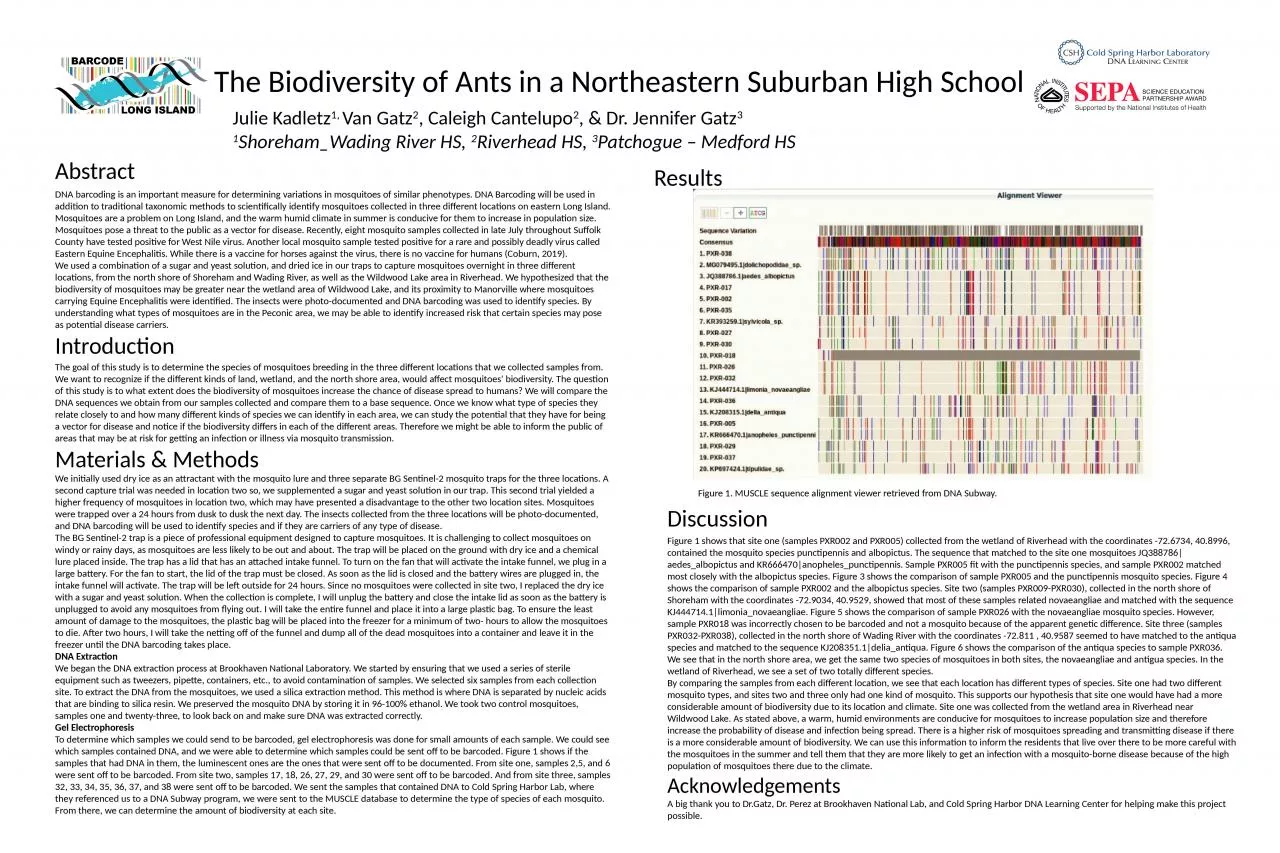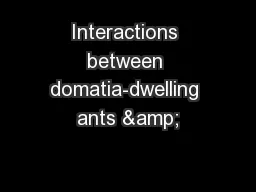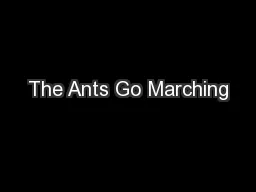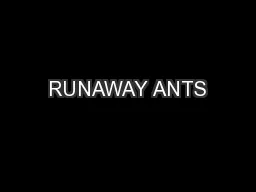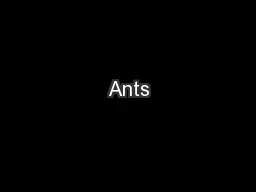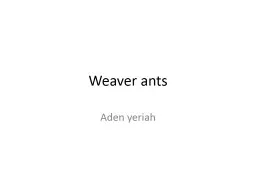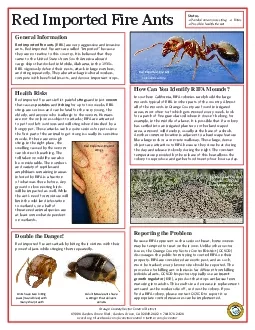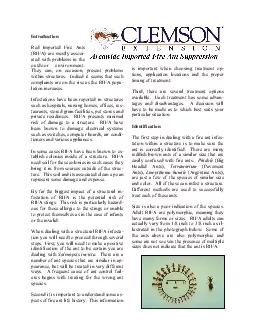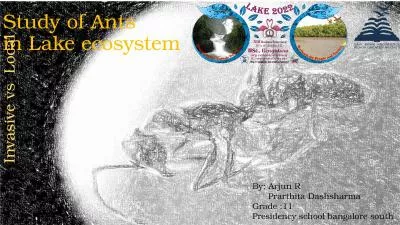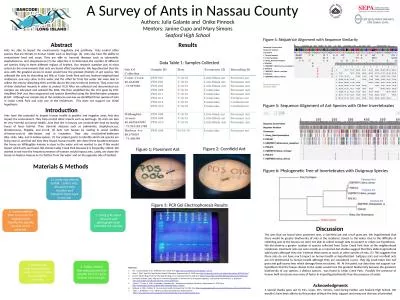PPT-The Biodiversity of Ants in a Northeastern Suburban High School
Author : beatrice | Published Date : 2022-06-11
Julie Kadletz 1 Van Gatz 2 Caleigh Cantelupo 2 amp Dr Jennifer Gatz 3 1 ShorehamWading River HS 2 Riverhead HS 3 Patchogue Medford HS Results Abstract
Presentation Embed Code
Download Presentation
Download Presentation The PPT/PDF document "The Biodiversity of Ants in a Northeaste..." is the property of its rightful owner. Permission is granted to download and print the materials on this website for personal, non-commercial use only, and to display it on your personal computer provided you do not modify the materials and that you retain all copyright notices contained in the materials. By downloading content from our website, you accept the terms of this agreement.
The Biodiversity of Ants in a Northeastern Suburban High School: Transcript
Julie Kadletz 1 Van Gatz 2 Caleigh Cantelupo 2 amp Dr Jennifer Gatz 3 1 ShorehamWading River HS 2 Riverhead HS 3 Patchogue Medford HS Results Abstract DNA barcoding is an important measure for determining variations in mosquitoes of similar phenotypes DNA Barcoding will be used in addition to traditional taxonomic methods to scientifically identify mosquitoes collected in three different locations on eastern Long Island Mosquitoes are a problem on Long Island and the warm humid climate in summer is conducive for them to increase in population size Mosquitoes pose a threat to the public as a vector for disease Recently eight mosquito samples collected in late July throughout Suffolk County have tested positive for West Nile virus Another local mosquito sample tested positive for a rare and possibly deadly virus called Eastern Equine Encephalitis While there is a vaccine for horses against the virus there is no vaccine for humans Coburn 2019 . by: Sarah 2-105. About Carpenter Ants. In an carpenter ants its body are just like you ! Its body parts are the Head, Thorax, Abdomen .. In a carpenter ant its easy to see there three body parts. Carpenter ants also have eyes, antennae , and a mouth. Carpenter ants eyes are not like yours. Some of us have eyes that have thousand of lenses. This is called composite eye.. Acacia erioloba. in Namibian savanna. Heather Campbell, Mark Fellowes & James Cook. School of Biological Sciences, University of Reading, Reading, RG6 6AS. Ants and . Acacias. Ant–plant associations are widespread (in over 100 genera of tropical angiosperms and at least 20 plant families and in five of 12 ant subfamilies. By Amy Heelan. Biodiversity !!. Biodiversity is all the living things on our planet .. Here are some examples, plants , animals and insects.. We should nurture and care for our planet as it is so important to us. . 1. st. Grade . Counting song with rhyming verses and in a minor key. The ants go marching one by one, hurrah, hurrah. . The ants go marching one by one, hurrah, hurrah.. The ants go marching one by one.. ACTIVITIES CARRIED OUT DURING PROJECT. Primarily. , . with. . the. . help. of . our. . experiment. ,. we. . observed. . that. . against. . which. . plants. . are. . the. . ants. . have. a . Remm. , Roland Matt. Quantum Adiabatic Computation. The . problems solved. The methods. Simulated annealing. Quantum adiabatic computation. Simulated . quantum annealing. Results. Comparing SA,QA, SQA. Where they live. weaver ants live in tree.. How they get there name. Weaver ant get there name by weaving. What they look like. Weaver ants look like brown ants.. What they do. WHAT THEY DO IS THEY WEAVE.. It is the variety of all the different living things and their homes on the planet. . BIO. . DIVERSITY. Bio= biological organisms . -living things!. diversity= the amount of variation. General InformationRedimportedx00660069reants RIFA are very aggressive and invasive antsRedimportedx00660069reantsarecalledimportedbecausetheyarenotnax00740069vetothiscountryItisbelievedthattheycameto is important when choosing treatment op-tions application locations and the proper timing of treatment Third there are several treatment options available Each treatment has some advan-Proper identif Fire ant colonies contain the queen(s), winged males and females, workers (wingless, sterile females) and brood (eggs, larvae and pupae).Fire ants create mounds up to 18" tall. They prefer open sunn University of California, San Francisco / California Childcare Health Program. HEALTHY SCHOOLS ACT APPROVED COURSE, 2023. https://www.cdpr.ca.gov/docs/schoolipm. https://cchp.ucsf.edu. . Funding for this program was provided through a grant awarded by the California Department of Pesticide Regulation (DPR). The contents of this document do not necessarily reflect the views and policies of DPR nor does mention of trade names or commercial products constitute endorsement or recommendation for use.. Invasive vs Local. By: Arjun R. . Prarthita. . Dashsharma. Grade :11. Presidency school . bangalore. south . INTRODUCTION. Ants might look like they don’t do much contribute in our surroundings but these facts might surprise /everyone.. Authors: Julia . Galante. and . Onike. . Pinnock. Mentors: Janine . Cupo. and Mary Simons. Seaford High School. Abstract. Ants are able to impact the environments negatively and positively. Ants control other species that are threats to human health such as bed bugs. (6) Ants also have the ability to contaminate food and crops. They are able to transmit diseases such as salmonella, staphylococcus, and streptococcus.(2) Our objective is to determine the number of different ant species living in three different regions of Seaford. Our research question was to what extent do the environments that ants are found affect biodiversity. We hypothesized that the area with the greatest access to water would have the greatest diversity of ant species. We collected the ants by disturbing ant hills at Cedar Creek Park and two Seaford neighborhood residences, one very close to the water and the other far from the water. We were able to collect the ants by disturbing their ant hills due to the ants territorial instincts. They come out of their disturbed mounds in order to protect it.(3) After we collected and documented our samples we extracted and isolated the DNA. We then amplified the the CO1 gene by PCR. Amplified DNA was then sequenced and species identified using the bioinformatics program BLAST. Although our sample size at the residences was low we identified three species of ants in Cedar Creek Park and only one at the residences. This does not support our initial hypothesis. .
Download Document
Here is the link to download the presentation.
"The Biodiversity of Ants in a Northeastern Suburban High School"The content belongs to its owner. You may download and print it for personal use, without modification, and keep all copyright notices. By downloading, you agree to these terms.
Related Documents

